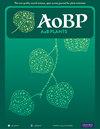澳大利亚本土草籽:宏观结构、微观结构和组织化学
IF 2.4
3区 生物学
Q2 ECOLOGY
引用次数: 0
摘要
由于殖民化,澳大利亚原住民对当地牧草谷物的利用和与国家的联系在很大程度上已经失去了。澳大利亚土著粮食生产有可能为土著人民和更广泛的社区带来环境、经济、营养和文化方面的好处。只有阐明谷物的相关特性,才能实现本地谷物食品系统的振兴。本研究的目的是表征四种澳大利亚本土草:Dactyloctenium radulans(纽扣草),Astrebla lappacea(卷Mitchell草),Panicum decompositum(本土谷子)和Microlaena stipoides(垂草)的颗粒结构和组织化学特征。对于这些物种,以及小麦和高粱,通过立体显微镜获得了全谷物图像,淀粉和胚胎被可视化,固定谷物的切片通过明亮视野和荧光显微镜成像。整个本地谷物的形状、大小和颜色因物种而异。除了垂草的糊粉层为两细胞厚外,本地种的糊粉层与驯化种的一样为一细胞厚。在乡土谷物中,胚乳细胞壁比小麦和高粱薄。钮扣草、卷毛草和土黍的淀粉粒主要分布在淀粉胚乳的中心区域,亚糊粉层中淀粉粒很少,而垂草的亚糊粉层中淀粉含量丰富。蛋白质在天然谷物的糊粉层和亚糊粉层中含量最高,尽管在钮扣草中,与小麦和高粱一样,淀粉质胚乳也富含蛋白质。在全粒中,本地种的胚比小麦大。在四种澳大利亚本地物种之间发现的谷物特性差异对气候变化中的农业食品工业具有重要意义。本文章由计算机程序翻译,如有差异,请以英文原文为准。
Indigenous Australian grass seeds as grains: Macrostructure, microstructure and histochemistry
Abstract Utilisation of grains of local grasses by Australia’s First Nations people for food and connection to Country has largely been lost due to colonisation. Native Australian grain production has the potential to deliver environmental, economic, nutritional and cultural benefits to First Nations people and the wider community. Revitalisation of the native grain food system can only be achieved if relevant properties of the grains are elucidated. This study aimed to characterise the grain structure and histochemistry of four Australian native grasses: Dactyloctenium radulans (Button Grass), Astrebla lappacea (Curly Mitchell Grass), Panicum decompositum (Native Millet) and Microlaena stipoides (Weeping Grass). For these species, as well as wheat and sorghum, whole-grain images were obtained via stereo microscopy, starch and the embryo were visualised, and sections of fixed grains were imaged via bright-field and fluorescence microscopy. The shape, size and colour of the whole native grains varied between the species. The aleurone layer was one-cell thick in the native species, as in the domesticated grains, except for Weeping Grass, which had a two-cell-thick aleurone. In the native grains, endosperm cell walls appeared thinner than in wheat and sorghum. Starch granules in Button Grass, Curly Mitchell Grass and Native Millet were found mainly in the central region of the starchy endosperm, with very few granules in the sub-aleurone layer, whereas Weeping Grass had abundant starch in the sub-aleurone. Protein appeared most abundant in the aleurone and sub-aleurone layers of the native grains, although in Button Grass, the starchy endosperm was observed to be rich in protein, as in wheat and sorghum. As a proportion of the whole grain, the embryo was larger in the native species than in wheat. The differences found in the grain properties among the four native Australian species have important implications for the agri-food industry in a changing climate.
求助全文
通过发布文献求助,成功后即可免费获取论文全文。
去求助
来源期刊

AoB Plants
PLANT SCIENCES-
CiteScore
4.80
自引率
0.00%
发文量
54
审稿时长
20 weeks
期刊介绍:
AoB PLANTS is an open-access, online journal that has been publishing peer-reviewed articles since 2010, with an emphasis on all aspects of environmental and evolutionary plant biology. Published by Oxford University Press, this journal is dedicated to rapid publication of research articles, reviews, commentaries and short communications. The taxonomic scope of the journal spans the full gamut of vascular and non-vascular plants, as well as other taxa that impact these organisms. AoB PLANTS provides a fast-track pathway for publishing high-quality research in an open-access environment, where papers are available online to anyone, anywhere free of charge.
 求助内容:
求助内容: 应助结果提醒方式:
应助结果提醒方式:


